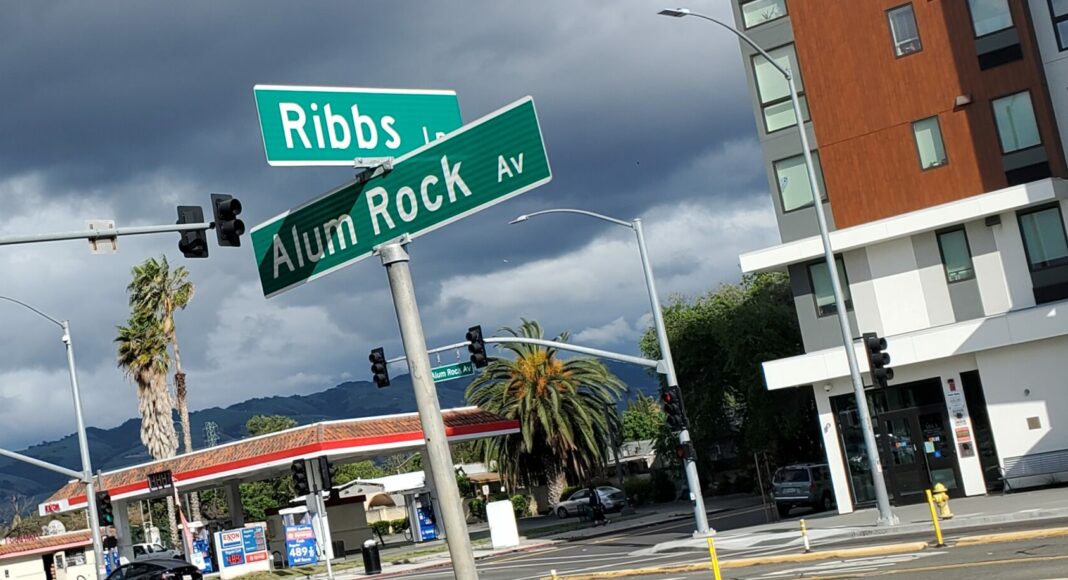Dead-end streets are often incubators of history, especially for suburban explorers.
In East San Jose, Ribbs Lane is an easy one. It only takes a minute to shuffle down the whole thing. As a result, the hideous concrete neighborhood of 680 and Alum Rock is much more interesting.
To the non-historian, or the newbie, Ribbs Lane appears as a tiny nondescript side street off Alum Rock, flanked by trees, just before one arrives at the gargantuan 680 apocalypse. An obligatory dead-end sign accompanies a few ominous warnings not to park here. I guess it happens all the time. Granted, there is not much to see, but one can easily imagine the grand sweep of history before the freeway happened.
The family that birthed Ribbs Lane should be celebrated over and over, and the family tree is quite a slice of San Jose history. Yet because the street sits “out there” on the east side, it doesn’t have the cachet of names like Naglee or Montgomery.
Born into a Louisiana farm family, Henry Ribbs arrived in San Jose in 1920. His wife, Nora, arrived two years later. After becoming a licensed plumber, Henry started his own company in 1927, Ribbs Plumbing, Heating, and Sheet Metal, a business that still exists today, and one that just might have been the first African American-owned company of its kind west of the Mississippi.
Henry built several houses on his own acreage along Alum Rock, before 680 existed, property that eventually included the street now bearing his name. After retiring, he lasted all the way to 1996, when he passed away at the ripe old age of 97, outliving Nora, who died in 1983, at the age of 83.
But that’s just Henry and Nora. From there, the descendants, the rest of this gargantuan and historic family, continued to make waves, both near and far. Since I don’t have room for it all, I’ll cherry-pick a few tidbits. Standing there at the dead-end of Ribbs Lane, I began to hear the roar of engines, and not just from the kids driving down Alum Rock, but from the annals of sports history.
You see, Henry’s grandson is the same Willy T. Ribbs who in 1991 became the first African American to qualify for the Indy 500. That was after he became the first African American to test an F1 car. Depending on who wrote the story, this San Jose native was either the Jackie Robinson of racing or the Muhammad Ali of racing.
A fairly recent documentary, Uppity: The Willy T. Ribbs Story, featured Willy telling sordid tales about the racism and bigotry he had to overcome in the racing industry. If he even complained about anything, white racers referred to him as “uppity” or “abrasive.” White sportswriters, even the local ones, likewise called him “brash” or “outspoken.” If two white drivers came to blows in the pits after a race, no one blinked an eye, but if Willy was angry about anything, well, he was “uppity.” Hence the title of the film.
Even before the documentary came out, the tribulations of Willy T. Ribbs were known throughout the world. The San Jose Sports Hall of Fame inducted him 10 years ago, but even still, he doesn’t seem to be enough of an everyday household name around here. He should be.
I can’t explain exactly why walking up and down Ribbs Lane for half a second somehow made me revisit the whole Willy T. Ribbs legend. One needn’t steal away off Alum Rock, with the dull roar of the freeway in the distance, to comprehend the swells of history. But it helped. I then went back and re-watched parts of Uppity and somehow it was a lot better.The Ribbs family are mentioned in a few books, including an amazing old do-it-yourself compendium titled History of Black Americans in Santa Clara Valley, which features interviews with a few of the Ribbs elders, as of 1978. Plus, last year’s amazing East Side Dreams exhibit at the Martin Luther King, Jr., Main Library even included a section about Ribbs Lane. Yet their story is usually ignored by the more vanilla-focused historians that have traditionally documented this town. Their history deserves to be elevated.



